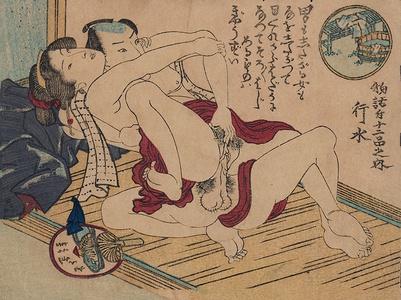| Method | Woodblock (nishiki-e) |
| Artist | Utagawa School |
| Published | c. 1840 |
| Dimensions | Yatsugiri-ban [~95 x 127 mm] |
| Notes |
Series: [Comparison of 12 Objects] A print from the series Comparison of 12 Objects and is titled Basu Mizu (bath water). Here an amorous couple enjoy a moment of bliss after having a bath. An inset image of a honoki (wooden bath tub), a bench and towel in the upper right in circle. Naked figures appear in ukiyo-e prints but the concept of the nude as genre in art did not appear until the introduction of Western painting styles after 1868; however, scenes in bath houses are not uncommon in ukiyo-e a whole and appear in shunga regularly. Japan had a long history of mixed public bathing that was part of the fabric of society until it was outlawed in 1791. While more strictly enforced in Edo and Kyoto is was less enforced in rural areas. It has been noted that segregated bathing lead to more peeping and the fetishized seeing the other sex naked thus heightening the sexual tension, taboo, and eroticism of these bathing prints. This size of shunga print was usually sold in sets of twelve in paper wrappers and often given as gifts at New Year in a similar fashion to surimono (privately commissioned greetings cards).As with surimono, these prints have been made using complex deluxe printing methods such as a large range of colours, complex patterns, and metallic pigments. Shunga is the term used for the body of erotic imagery produced in Japan from 1600 to 1900. The term shunga means spring pictures, a euphemism for sex, and is one of several names for erotic material produced in Japan. Shunga took different formats: painted hand scrolls, painted books, printed books and albums, and sets of prints which were sometimes sold in wrappers. As prints they are one of the genres of ukiyo-e, or Floating World prints, which also include fukeiga (landscape prints), and bijin-ga (prints of beautiful women). Most of the major ukiyo-e artists produced shunga material at some point during their careers, including Utamaro (who produced more erotic books than non-erotic books), Hokusai, and Hiroshige. Produced at the same time as the introduction of full colour woodblock printing, shunga prints and books were made using the most lavish and complicated printing techniques, including gauffrage, metallic inks, mica, complicated printed patterns, and multicolour printing using a high number of different colours. Although prolific in its number and variety, shunga should be seen as more representative of the ideals of the ukiyo, with its emphasis on mutual pleasure, rather than as an accurate representation of Japanese attitudes and practices of sexuality. Shunga present an invitation to pleasure through the bliss of lovemaking and though largely heteronormative, they portray the full gamut of couplings, married or otherwise, often surrounded by lavish settings and objects of pleasure. Utagawa School was the largest school of ukiyo-e art founded by Utagawa Toyoharu. After Toyoharu died his main pupil Utagawa Toyokuni I took over and led the group to be the biggest and most influential woodblock school of the 19th century. Pupil include Kunisada, Kuniyoshi, Hiroshige, and Yoshitoshi. Utagawa School is used an attribution when prints are unsigned and in the style of the school. Due to the punitive restrictions on shunga prints many works were produced without signatures or with pseudonyms. Ex. col.: Peter Darach Condition: Two tiny areas of loss along top edge of sheet. |
| Framing | mounted |
| Price | £150.00 |
| Stock ID | 53225 |

